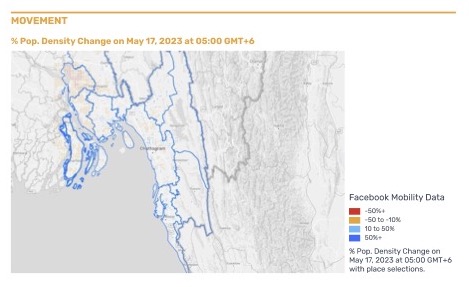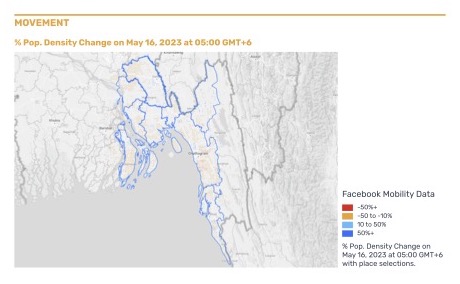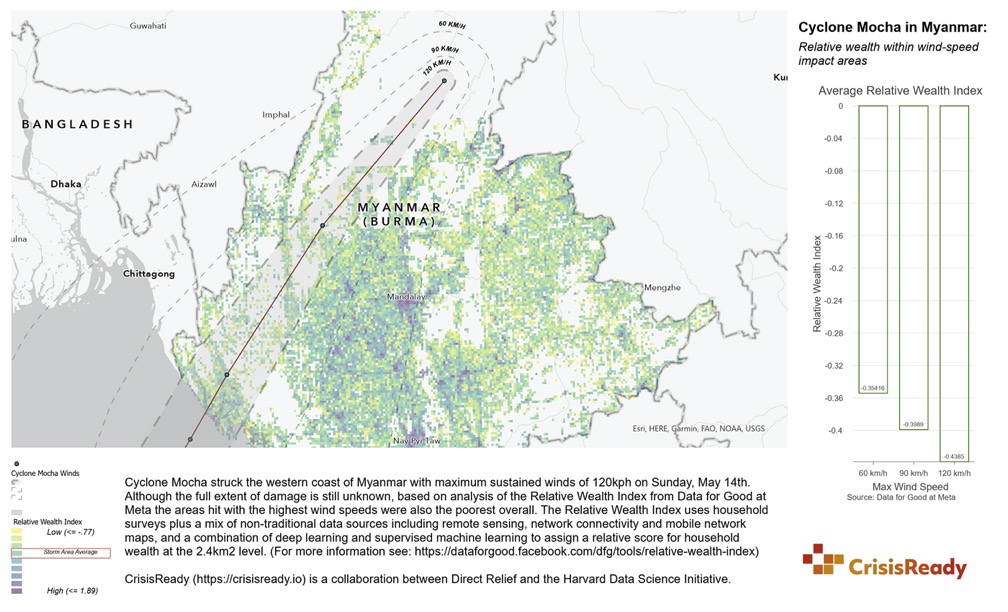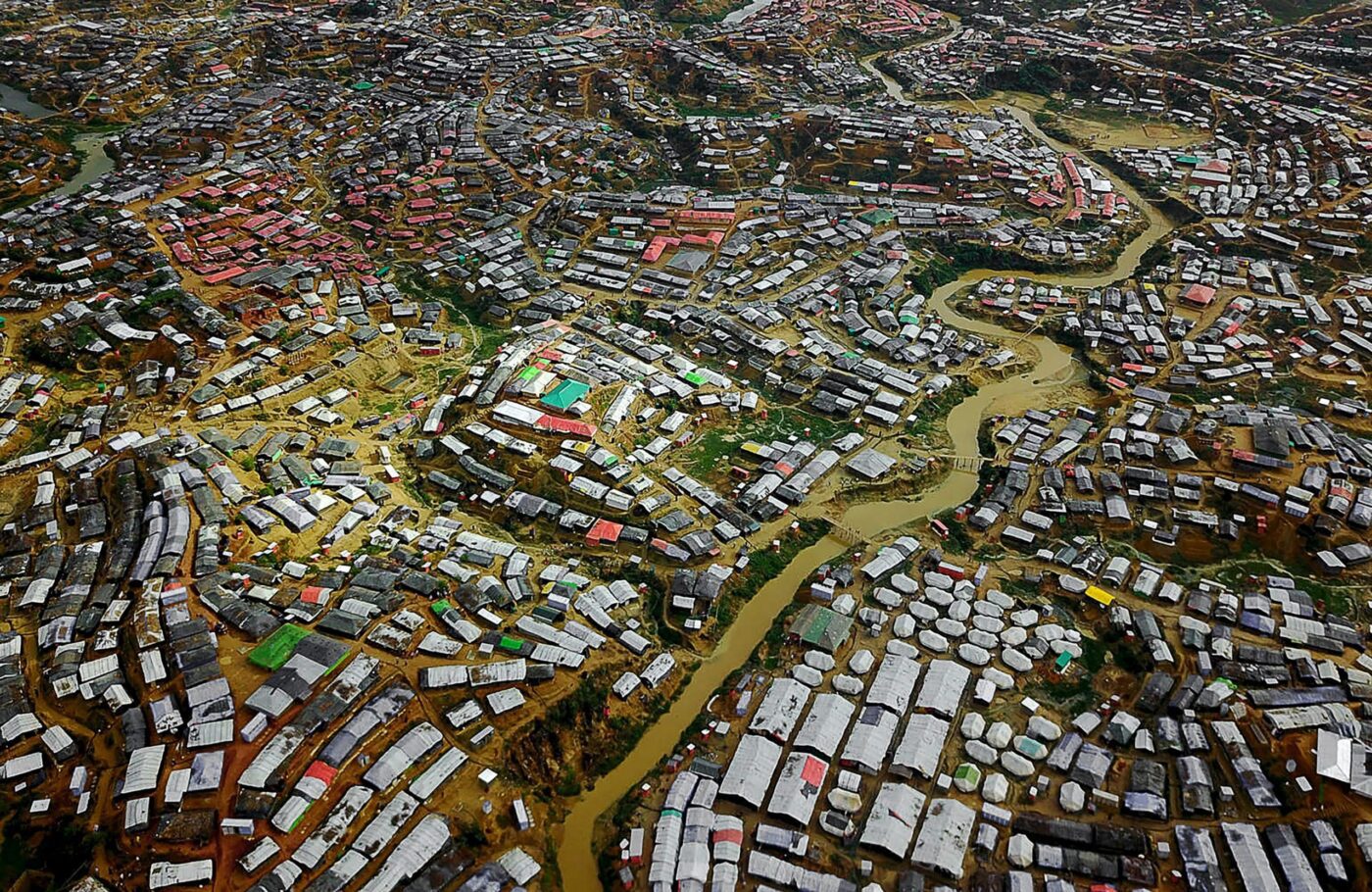Reports & Data Updates
All CrisisReady data reports can be found on ReliefWeb. CrisisReady’s organization page can be found here.
Wed, May 17, 2023
Southern Bangladesh | 05:00 GMT+6
This report provides information on population movement, baseline population vulnerabilities, and healthcare infrastructure in Bangladesh as of Wednesday, May 17, 2023, three days after Cyclone Mocha made landfall in the country.
Key Observations:
- As of the morning of May 17, population densities in the most affected area of Cox’s Bazar have returned to baseline values.
- Within Cox’s Bazar, the exception to this rule is near the Rohingya camps, which continues to see rates of decrease between -10% and -50%.
- The most significant decreases in population were seen to the North of Cox’s Bazar, in Bhola, Lakshmipur, and Chandpur.
- These three districts all show decreases in population density ranging between -5% and -29%, with the greatest decreases happening on the night of May 16.
- The city of Chittagong, however, saw modest increases in its population density (+1%), and a significant rate of mobility within the city itself (+22%).

Tues, May 16, 2023
Southern Bangladesh | 05:00 GMT+6
This report provides information on population movement, baseline population vulnerabilities, and healthcare infrastructure in Bangladesh, following Cyclone Mocha’s landfall in the region on Sunday, May 14, 2023.
Key Observations:
- Cox’s Bazar, where the largest settlement of refugees in the world is located, showed a rapid decrease in population densities, ranging between -10% to -30%.
- Surrounding areas, including Bhola, Chittagong (Chattogram), and Lakshmipur showed modest rates of increasing population densities, around +10%.
- Network infrastructure remained mostly operational throughout this time period, which lends evidence to these relative increases being principally related to population movement.
- The storm caused lower impacts than expected, which aligns with the rapid speed of return to baseline population densities in most areas by May 16.
- Relatively higher rates of decrease could be seen throughout the more rural interior areas, away from urban centers on the coast.

Tues, May 16, 2023
Myanmar (Burma)
This report provides information on the economic status of the regions in Myanmar most affected by Cyclone Mocha, which made landfall in the country of Sunday, May 14.
The report was generated using the Relative Wealth Index from Data for Good at Meta. The Index uses household surveys, non-traditional data sources, deep learning and supervised machine learning to assign a relative score for household wealth at the 2.4km2 level.
Key Observation:
- Although the extent of the storm’s damage is still relatively unknown, the Relative Wealth Index from Data for Good at Meta suggests that the most impacted areas were also the poorest, overall.

About the Cyclone
Cyclone Mocha, which reached a category-five status before hitting Myanmar’s Rakhine state on Sunday, May 14th, has resulted in widespread environmental damage, infrastructure destruction, and displacement of populations in the affected regions. At the time of landfall, winds reached up to 130 miles per hour (209 kilometers per hour).
The Cyclone is one of the strongest storms this century to strike the Bay of Bengal. The immediate impact of Mocha caused the deaths of a minimum of six people on Sunday. Shortly after, Myanmar’s military leaders announced Rakhine state as a natural disaster area.
Several buildings and homes have sustained damage, and hundreds of individuals have been injured from the cyclone’s impact. The hazards of the storm have been worsened by downed power lines, which have also significantly impaired lines of communication.
According to Save The Children, more than 1.5 million children are at risk, as Cyclone Mocha is expected to make landfall near the Bangladesh border on Sunday morning and threatens to be a major humanitarian disaster. Additionally, the organizations estimates that around 4.6 million people will be exposed to wind speeds of over 110 kilometers per hour and rough seas could reach astronomical surge heights of 12 feet as the dangerous cyclone crosses Cox’s Bazar coast.
The military junta had already restricted the provision of life-saving assistance and confined over 100,000 Rohingya refugees to internal displacement camps in Myanmar’s Rakhine state, which has suffered significant destruction from the Cyclone. As the full scale of the disaster is becoming more apparent, aid organizations must guarantee an inclusive response for everyone affected, including refugees and internally displaced persons.
Refugees International’s Director for Africa, Asia, and the Middle East, Daniel P. Sullivan, released the following statement:
“Rohingya in the largest refugee settlement in the world in Bangladesh have expressed fear of being forgotten and having nowhere to go to stay safe amid the storm. Failure to evacuate Rohingya from the camps—or even let them leave—has endangered countless lives. While the nightmare scenario of a direct hit on the camps was avoided, Cyclone Mocha underscores the ongoing vulnerability of the camps at a time of quickly declining humanitarian funding.

Image by: Omar Munna
CrisisReady is generating periodic situation reports to track the displacement of affected communities as the global emergency and humanitarian response community addresses the aftermath of the disaster. These situation reports will provide near real-time updates on the evolving emergency situation, helping international response agencies to gain a better understanding of the areas and populations affected by the disaster. The aim of these reporting efforts is to streamline the dissemination of critical information necessary for effective response planning and material aid deployment. By having a more accurate understanding of the situation on the ground, international response agencies can better allocate resources and support services more precisely to those in need, reducing the risk of aid being misdirected or underutilized.